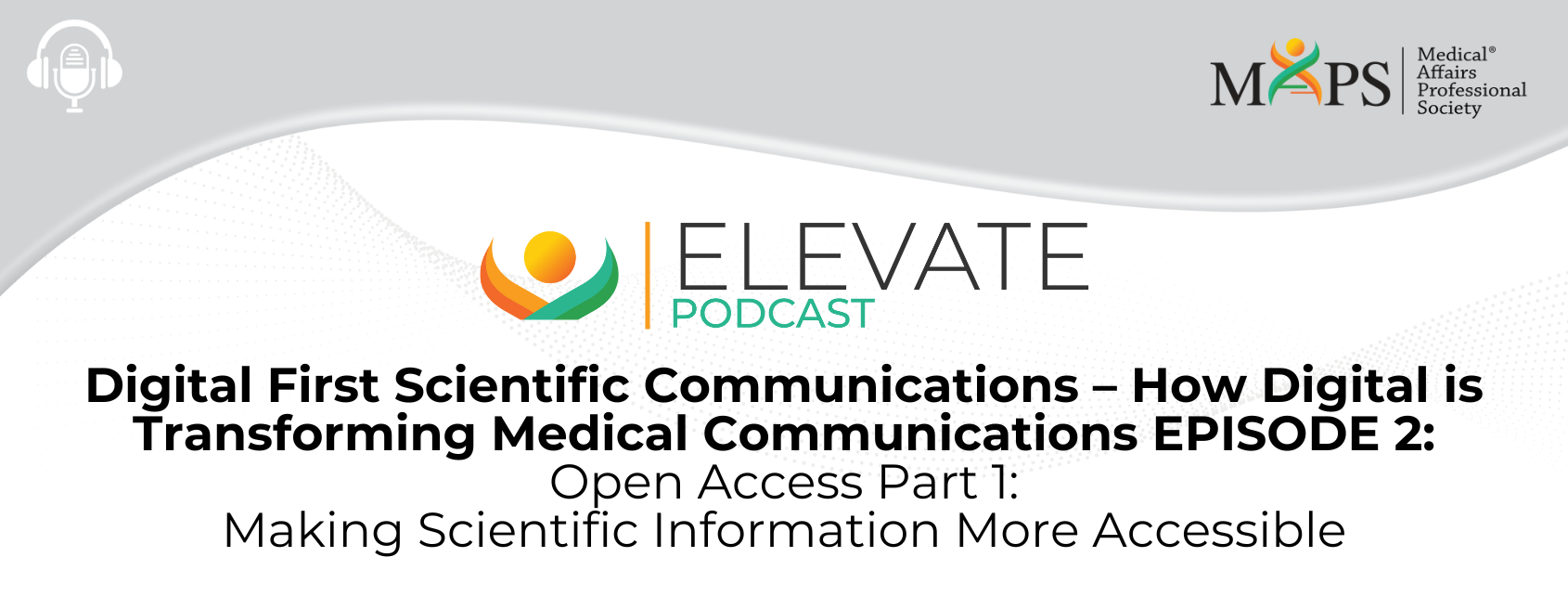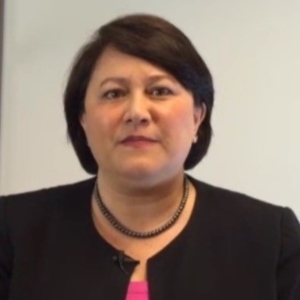Digital First Scientific Communications – How Digital is Transforming Medical Communications EPISODE 2:
Open Access Part 1:
Making Scientific Information More Accessible
Speaker: Jennifer Riggins
Speaker: Steve Casey
Speaker: Catherine Skobe
This podcast series focuses on how digital is transforming scientific communications.
In this, our second episode this season, we’ll be discussing open access in medical publishing from the biopharma perspective.
Following is an automated transcription provided by otter.ai. Please excuse inaccuracies.
Jennifer Riggins 00:00
Welcome to the Medical Affairs Professional Society Digital Focus Area Working Groups podcast series, Digital First scientific communications, how Digital is transforming medical communications. In our podcast, we speak with experts in the field of scientific communication, and discuss how the Digital transformation of medical publishing is opening opportunities for medical communicators. I’m Jennifer Riggins. I’ll be the moderator for today’s podcast. I currently serve as a member of the Digital Focus Area Working Group. I’ve worked in pharma for almost 30 years with a focus on Medical Information, Scientific Communications and Medical Digital. I’m joined by Steve Casey of Omni Healthcare Communications or Omni HC for short, a leader in Digital First Medical Communication.
Steve Casey 00:49
The views expressed in this recording are those of the individuals and don’t necessarily reflect on the opinions of MAPS or the companies which they are affiliated. This presentation is for informational purposes only, and is not intended as legal or regulatory advice.
Jennifer Riggins 01:05
We encourage you to learn more about Digital optimization of medical communications. There are many enduring educational materials available through math, including the first season of this podcast, elevate articles on audience amplification and contemporary publication planning, and amplification webinar, and Annual Meeting workshops that have been recorded and are housed on the MAPS website. Today, today’s podcasts objectives are for listeners to better understand how and why medical communication is changing and where it’s going in the future. The benefits of Digital First development of manuscripts, and then how enhanced content can improve publication access and resonance. In this our second episode this season, we’ll be discussing open access in medical publishing from the biopharma perspective with Catherine Skobe. Catherine is the Publications Innovative Solutions lead at Pfizer. Welcome Catherine. Thank you for joining us today. To start please give us a brief background of your career and the responsibilities of being the Publications Innovative Solutions lead at Pfizer.
Catherine Skobe 02:22
Sure, thank you, Jennifer and Steve for inviting me to speak with you today. I’ve been with Pfizer for 15 years working on the publication’s management team, which I co lead. Previously, I’ve had positions in clinical chemistry and clinical research at a university hospital as well as a medical device company. I also had a brief stint at a med comms agency before coming to Pfizer. As innovative solutions lead, I’ve been driving change in our day to day operations through our non novel publications management system, as well as focusing on other aspects of our field, such as open access, publishing, and working with a group of patient advocacy leaders to ensure we understand the needs of their communities. They have been very supportive of our mission to increase open access publishing,
Jennifer Riggins 03:19
So, you have a lot of great experience to share with our audience. Since this podcast is all about open access, maybe we should start off by doing this a little bit of a level set. We want all the listeners to have a good idea of open access as we move into our discussion. So Catherine, could you just discuss for the listener what open access is and what the advantages and disadvantages of open access are for the biopharma scientific medical publishing community and how are biopharma companies approaching the use of open access?
Catherine Skobe 03:52
Sure, the nuances of open access publishing, and the various copyright license types can be really complex. For us at Pfizer, the bottom line is really about providing accessibility to biomedical research, available in peer reviewed publications, really for anyone, whether it’s gold, hybrid green or bronze open access. This initiative is intended to provide access to the most recent research to improve healthcare outcomes. As a biopharma company, we have more flexibility and choosing gold and hybrid open access journals and our publications. green open access, which is through an author’s repository is an area that we’ve been exploring. And obviously because bronze Oh A is selected by the editor of the journal, we really don’t have a choice and how that is achieved. So ultimately, for US Open Access publishing is the gateway to Open Science, and about five years ago, we joined an organization called Open pharma, with a few other pharma companies. And this was to support the initiative of open access publishing. What we found as a collective, we can do a lot to increase access to research through open access publishing.
Steve Casey 05:20
Hi, Catherine, it’s so good to speak with you again, when when we were last talking about the potential of you joining us on this podcast, we discuss the basics of open access. But when we peel back the onion of an open access, it’s something that is directly related to the Digital transformation of the publishing industry. Neal print publishing model, the closest thing to open access for free, the free subscription advertising supported journals. What does today’s version of open access do for scientific exchange and patient outcomes?
Catherine Skobe 05:53
Well, that’s a really good point, Steve. Full open access journals, many of which are online only are part of the Digital transformation of publishing. In addition to increasing access to research, this model supports the evolution of how we measure impact and engagement. No longer is impact solely about impact factor of journals, which is based on a calculation based on citations, but really impacts about the addition of alternative metrics. These alternative metrics allow us to monitor scientific exchange, and Digital online sources. That includes including conversations that we hear from patient organizations. And this level of engagement provides a feedback loop that can affect change and publication planning. Online only journals also support environmental sustainability. And they liberate us from paper use. I’ve heard from at least one publisher that they offer online journals exclusively.
Jennifer Riggins 07:05
So that’s really interesting. As the head of publication innovation, Catherine, I’m blessed, I’m guessing that you are most likely at the forefront learning about innovations that are happening, especially in the medical publishing industry. And I’m sure this has been the case with open access as well. Can you give us some idea of how you encourage or gain commitment from publications teams to use open access?
Catherine Skobe 07:32
Yeah, the Pfizer publications management team has really dedicated a lot of their time over the past several years in educating our scientific publication committees, on both the importance and the value of open access publishing. Over the past two years, we’ve made a commitment within Pfizer to increase open access publishing to 95%. And each year, we’re getting closer. And we’ve achieved this with out a policy. In this past year in 2021, we were able to obtain 85%, open access publishing. And one of the other caveats I’d like to add is one of the reasons we aren’t mandating open access publishing is that we want to give authors the academic freedom to choose their target journals, which keeps us in adherence to ICM je authorship criteria. However, we also want to provide recommendations of Open Access Journals, as well as inform our scientific publication committees and the external authors we work with that we will pay the article processing fees that go along with open access publishing.
Steve Casey 08:54
We’ve been talking a lot about open access in the general sense. But can we take a moment to talk about full open access journals versus open access and paywall journals as a leader in the use of open access to use open access journals? And do you find them to have benefits and drawbacks when compared to standard paywall journals?
Catherine Skobe 09:13
That’s another really good question. You know, at Pfizer, we turn to them equally, as the authors are the ones who select the journals. However, personally, I believe that fully open access journals are where real differences being made, and transforming the publication’s field for the future. Any paywall that prevents an HCP particularly those who are community based or from low to mid income countries, from where they can’t access the information that they need to make informed decisions for their patients really isn’t justifiable. My understanding is that there will take you know some time for journals to convert their business models, which makes total sense. But there are journals who are fully open access from the start, who shouldn’t be overlooked.
Steve Casey 10:10
Just as a follow up to my last question, do you see any difference between the two different style publication platforms with open access and publishing enhanced content, such as video abstracts, data visualizations, plain language summaries, or audio files?
Catherine Skobe 10:26
I think the obvious answer is that if you are a subscription-based journal that’s only in print predominantly, or maybe even printing online, you’re missing the advancements from enhanced content. The interactive data visualizations we’ve seen during the pandemic are extraordinary, and capturing layers of data. We’ve heard time and again, that plain language summaries are beneficial not just to patients, but also to physicians and HCPs. And, and, you know, the Digitally native generation is getting their information from video and audio. So, and we’ve also seen a single QR code can carry a lot of content. So the advantages to being online only are far too great to ignore.
Jennifer Riggins 11:18
Absolutely. So I also know a lot of people are looking at copyrights nowadays. And there are different kinds of copyrights at different publishers. How does open access affect the copyright? And are there any places where you see biopharma can obtain or negotiate a better better copyright position because of open access?
Catherine Skobe 11:42
So that’s really an area that we’ve been exploring. At this point. It’s really too early for us to tell at Pfizer specifically, I know that academic institutions are benefiting from transformative agreements. But for us collecting the data, ensuring it is accurate spin a big undertake undertaking it this time. But ideally, it would be great if biopharma companies were offered the same types of copyright licenses made available to academic institutions and NGOs, because what we’re finding is we’re still combating a discrepancy in what’s offered between corporate companies versus academic institutions.
Steve Casey 12:32
We’ve discussed a lot about enhanced publication content, making content accessible, and this podcast episode is being dropped in time to coincide with open access week. Could you take a moment to talk about open access week and what it’s all about what it is what it would be of how it would be a benefit to biopharma scientific communicators?
Catherine Skobe 12:52
Sure, I love talking about open access week. So this year, open access week is October 24, through 30th. And for us, it’s it’s really a time to highlight the purpose, and the need to support open access publishing. at Pfizer, our team pulls together educational materials for our colleagues, to learn about why open access publishing is important, and really, so that they can use this information to inform their networks. In the past, during this week, we’ve held webinars with experts. We’ve had hosted podcasts, we’ve interviewed our patient advocates on what open access means to them to convey that importance. For example, when you’re a patient with a rare disease, you want access to as much information as possible. So open access publishing, allows that accessibility. Interestingly, this year’s theme is on climate justice, we will be highlighting the various diseases and health care issues impacted by climate change and environmental concerns such as drought and unclean water. So making biomedical research available to investigators affected by these conditions can only help drive change and eventually improve health outcomes. And ultimately, isn’t that what we’re all striving to do?
Jennifer Riggins 14:19
For sure. It sounds like it’s going to be a really great open access week. So Catherine, Stephen, I want to thank you for joining us today and being a part of our podcast theory. It’s been very informative, and I’m sure it will be of help to the audience. And speaking of audience. If you liked this episode, look for our next episode, where we will discuss Digital First publications with a representative from one of the largest medical publishing firms in the world. So just a little teaser for you. Until then, this has been Jennifer Riggins and Steve Casey, bringing you another episode of Digital First scientific communications, a podcast production of the Digital Focus Area Working Group at the Medical Affairs Professional Society.
Steve Casey 15:04
If you’re a MAPS member, thank you for your support of MAPS. If you’re not yet a MAPS member, I want to encourage you to join so you can access additional resources such as the one mentioned in this podcast. Visit the MAPS website today MedicalAffairs.org/membership. And so ends our podcast.






